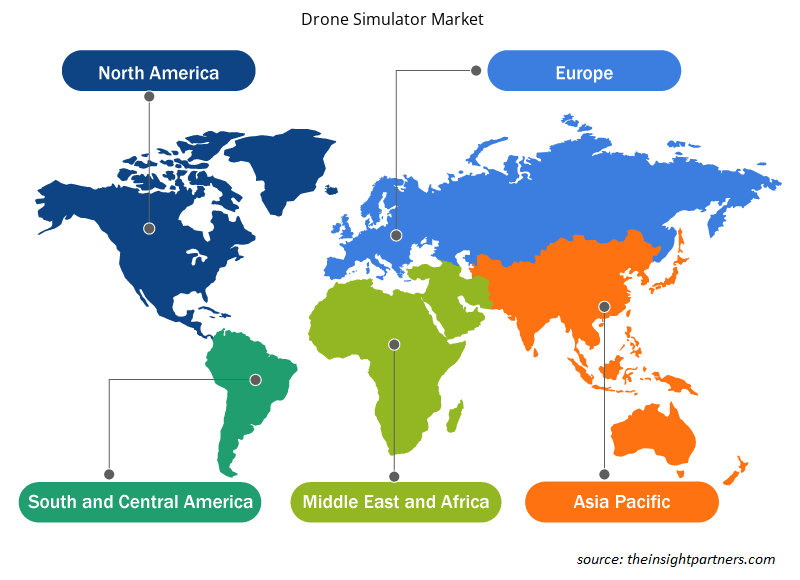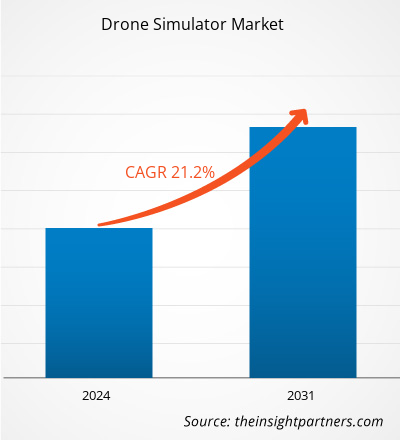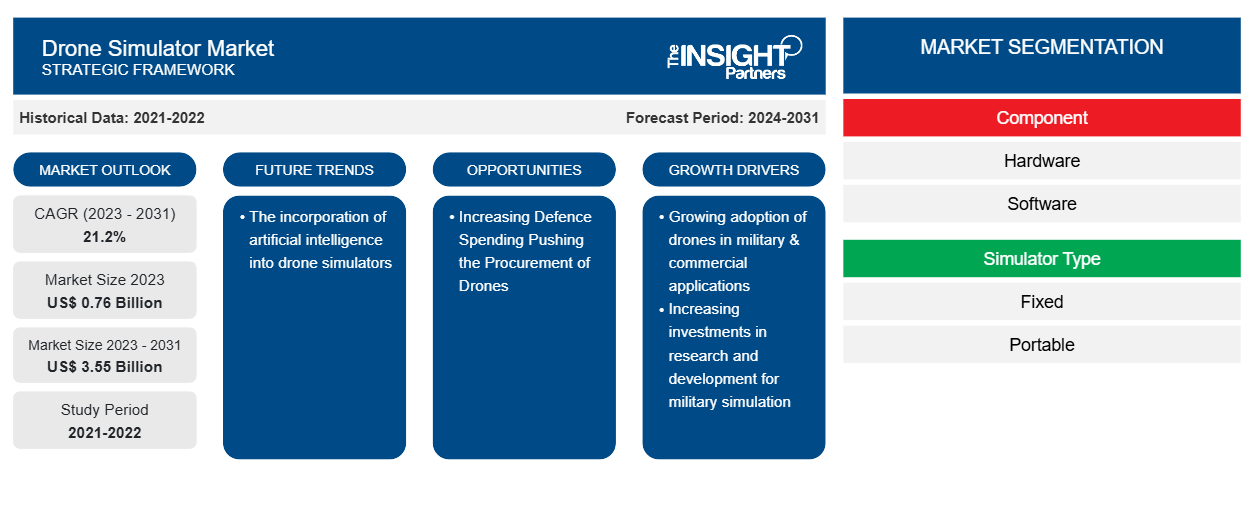Si prevede che la dimensione del mercato dei simulatori di droni raggiungerà i 3,55 miliardi di dollari entro il 2031, rispetto ai 0,76 miliardi di dollari del 2023. Si prevede che il mercato registrerà un CAGR del 21,2% nel periodo 2023-2031. È probabile che l'incorporazione dell'intelligenza artificiale rimanga una tendenza chiave nel mercato.
Analisi di mercato dei simulatori di droni
Il mercato dei simulatori di droni è dominato principalmente da produttori leader del settore come Aegis Technologies; Leonardo Spa; General Atomics; Israel Aerospace Industries tra gli altri. La domanda di questi connettori tra i produttori di UAV è ai massimi storici. La presenza e la forte immagine del marchio di produttori riconosciuti dal settore limitano l'emergere di nuovi attori nel mercato. Inoltre, la produzione di simulatori di droni richiede l'aderenza a diversi standard stabiliti dalle rispettive autorità governative e l'acquisizione della licenza per la produzione di tali prodotti è un processo ad alta intensità di capitale. Tale enorme requisito di capitale è un altro fattore che limita l'ingresso di attori emergenti in questo mercato.
Panoramica del mercato dei simulatori di droni
I principali stakeholder nel mercato dei simulatori di droni sono i fornitori di componenti, i fornitori di simulatori di droni e gli utenti finali. I venditori di elettronica forniscono componenti elettronici come sensori, telecamere e componenti passivi, tra gli altri, ai fornitori di simulatori di droni per la produzione di simulatori di droni (hardware). Gli utenti finali possono ottenere un simulatore di droni per numerosi tipi di droni a seconda della loro applicazione dai fornitori di simulatori di droni. Devono essere rispettate diverse norme normative prima che questi simulatori possano essere prodotti. Il fornitore di simulatori di droni possiede fondamentalmente la competenza tecnologica per fornire all'industria militare e aerospaziale un sistema di simulazione efficace e affidabile. Infine, gli utenti finali come le organizzazioni commerciali e militari utilizzano il simulatore di droni per testare varie applicazioni.
Personalizza questo report in base alle tue esigenze
Riceverai la personalizzazione gratuita di qualsiasi report, comprese parti di questo report, o analisi a livello nazionale, pacchetto dati Excel, oltre a usufruire di grandi offerte e sconti per start-up e università
-
Scopri le principali tendenze di mercato in questo rapporto.Questo campione GRATUITO includerà analisi di dati che spaziano dalle tendenze di mercato alle stime e alle previsioni.
Driver e opportunità del mercato dei simulatori di droni
Aumento degli investimenti in ricerca e sviluppo per la simulazione militare
I ministeri militari di molte nazioni stanno tagliando le spese di addestramento e ridimensionando le loro forze. Di conseguenza, l'attenzione dell'esercito si è spostata verso la ricerca di soluzioni meno costose e più efficaci per le loro esigenze. L'addestramento in tempo reale richiede tempo e denaro. Inoltre, necessita di un'enorme quantità di risorse grezze, come benzina ed esplosivi, e comporta un alto livello di pericolo. Pertanto, i ministeri militari preferiscono sempre di più l'addestramento virtuale e i giochi basati sulla simulazione che utilizzano tecnologie come big data, intelligenza artificiale e cloud computing. La simulazione militare e l'addestramento virtuale stanno diventando sempre più popolari tra le forze militari in tutto il mondo perché si basano su componenti commerciali già pronti (COTS) e aiutano a ridurre al minimo le spese di addestramento. I simulatori sono realizzati con un costo di sviluppo minimo. I criteri sono fondamentali per l'esercito per innovare massicciamente nella tecnologia di addestramento basata sulla simulazione. Le simulazioni di droni vengono attualmente utilizzate per addestrare i futuri soldati e rappresentare uno scenario in tempo reale utilizzando impostazioni digitali realistiche. Quindi, le maggiori spese nel software di simulazione guidano la crescita del mercato dei simulatori di droni. Inoltre, i ministeri della difesa di diverse nazioni stanno ristrutturando e modificando i loro eserciti utilizzando nuove soluzioni, il che sta ulteriormente rafforzando la crescita del mercato.
L’aumento della spesa per la difesa spinge all’acquisto di droni
Il rapido cambiamento nella guerra moderna ha spinto i governi a stanziare importi maggiori per le rispettive forze militari. Il budget assegnato all'esercito aiuta le forze militari a impegnarsi nello sviluppo di solide tecnologie indigene e nell'approvvigionamento di armi, armamenti, veicoli e altre attrezzature avanzate da produttori internazionali. C'è un aumento nell'adozione di sistemi senza pilota tra la maggior parte delle forze militari al fine di mantenere il personale e i veicoli pronti per la missione. Con l'obiettivo di modernizzare soldati e veicoli, i ministeri della difesa in tutto il mondo stanno investendo ingenti somme in tecnologie più recenti, compresi i sistemi di droni. Questo fattore sta stimolando la crescita del mercato dei simulatori di droni per fornire l'addestramento dei droni acquistati tra le forze armate. Secondo lo Stockholm International Peace Research Institute (SIPRI), la spesa militare globale è salita a 2.443 miliardi di dollari nel 2023, registrando un aumento di circa il 13% rispetto al 2022. I paesi chiave nel 2023, che hanno rappresentato circa il 60% della spesa globale, includono Stati Uniti, Cina, India, Russia e Arabia Saudita. Tali investimenti hanno incrementato gli acquisti e gli ordini di simulatori di droni da diversi paesi in tutto il mondo, stimolando ulteriormente la crescita del mercato.
Analisi della segmentazione del rapporto di mercato dei simulatori di droni
I segmenti chiave che hanno contribuito alla derivazione dell'analisi di mercato dei simulatori di droni sono i componenti, il tipo di simulatore, il tipo di drone e la tecnologia.
- In base al componente, il mercato dei simulatori di droni è segmentato in hardware e software. Il segmento hardware ha detenuto una quota di mercato maggiore nel 2023.
- In base al tipo di simulatore, il mercato dei simulatori di droni è segmentato in fisso e portatile. Il segmento fisso ha detenuto una quota di mercato maggiore nel 2023.
- In base al tipo di drone, il mercato dei simulatori di droni è segmentato in ala fissa e ala rotante. Il segmento ad ala fissa completa ha detenuto una quota di mercato maggiore nel 2023.
- In base alla tecnologia, il mercato dei simulatori di droni è segmentato in realtà aumentata e realtà virtuale. Il segmento della realtà virtuale ha detenuto una quota di mercato maggiore nel 2023.
Analisi della quota di mercato dei simulatori di droni per area geografica
L'ambito geografico del rapporto sul mercato dei simulatori di droni è suddiviso principalmente in cinque regioni: Nord America, Europa, Asia Pacifico, Medio Oriente e Africa e Sud America.
Il Nord America ha dominato il mercato nel 2023, seguito da Europa e regioni dell'Asia Pacifica. Inoltre, è probabile che anche l'Asia Pacifica registri il CAGR più elevato nei prossimi anni. Gli Stati Uniti hanno dominato il mercato dei simulatori di droni del Nord America nel 2023. La crescita del mercato dei simulatori di droni negli Stati Uniti è dovuta all'uso dei droni in applicazioni militari e commerciali. I droni sono utilizzati dalle forze militari statunitensi per la consapevolezza della situazione. La consapevolezza della situazione fornisce informazioni in tempo reale sulle posizioni nemiche, sul terreno, sulle condizioni meteorologiche e su altre variabili mutevoli. I droni aiutano a ottenere informazioni sulle posizioni delle truppe in una zona di guerra per prendere decisioni migliori. Dopo la fine della guerra, i droni vengono utilizzati nell'analisi dei danni per la valutazione della battaglia. Inoltre, con la crescente spesa per la difesa degli Stati Uniti, l'implementazione dei droni è aumentata. Ad esempio, gli Stati Uniti hanno speso circa 916 miliardi di dollari in spese militari nel 2023, con una crescita di circa il 4,6% rispetto alla spesa del 2022 che era di circa 876 miliardi di dollari. Tali fattori hanno spinto l'adozione del mercato dei simulatori di droni.
Approfondimenti regionali sul mercato dei simulatori di droni
Le tendenze regionali e i fattori che influenzano il mercato dei simulatori di droni durante il periodo di previsione sono stati ampiamente spiegati dagli analisti di Insight Partners. Questa sezione discute anche i segmenti e la geografia del mercato dei simulatori di droni in Nord America, Europa, Asia Pacifico, Medio Oriente e Africa e America meridionale e centrale.

- Ottieni i dati specifici regionali per il mercato dei simulatori di droni
Ambito del rapporto di mercato sui simulatori di droni
| Attributo del report | Dettagli |
|---|---|
| Dimensioni del mercato nel 2023 | 0,76 miliardi di dollari USA |
| Dimensioni del mercato entro il 2031 | 3,55 miliardi di dollari USA |
| CAGR globale (2023-2031) | 21,2% |
| Dati storici | 2021-2022 |
| Periodo di previsione | 2024-2031 |
| Segmenti coperti |
Per componente
|
| Regioni e Paesi coperti |
America del Nord
|
| Leader di mercato e profili aziendali chiave |
|
Densità dei giocatori del mercato dei simulatori di droni: comprendere il suo impatto sulle dinamiche aziendali
Il mercato dei simulatori di droni sta crescendo rapidamente, spinto dalla crescente domanda degli utenti finali dovuta a fattori quali l'evoluzione delle preferenze dei consumatori, i progressi tecnologici e una maggiore consapevolezza dei vantaggi del prodotto. Con l'aumento della domanda, le aziende stanno ampliando le loro offerte, innovando per soddisfare le esigenze dei consumatori e capitalizzando sulle tendenze emergenti, il che alimenta ulteriormente la crescita del mercato.
La densità degli operatori di mercato si riferisce alla distribuzione di aziende o società che operano in un particolare mercato o settore. Indica quanti concorrenti (operatori di mercato) sono presenti in un dato spazio di mercato in relazione alle sue dimensioni o al valore di mercato totale.
Le principali aziende che operano nel mercato dei simulatori di droni sono:
- Tecnologie Aegis
- CAE Inc
- Atomica generale
- Havelsan AS
- Industrie aerospaziali israeliane Ltd
- Formazione e simulazione L3 Link
Disclaimer : le aziende elencate sopra non sono classificate secondo un ordine particolare.

- Ottieni una panoramica dei principali attori del mercato dei simulatori di droni
Notizie e sviluppi recenti sul mercato dei simulatori di droni
Il mercato dei simulatori di droni viene valutato raccogliendo dati qualitativi e quantitativi dopo la ricerca primaria e secondaria, che include importanti pubblicazioni aziendali, dati di associazioni e database. Di seguito sono elencati alcuni degli sviluppi nel mercato dei simulatori di droni:
- CAE ha annunciato di aver raggiunto un accordo formale con L3Harris Technologies (NYSE: LHX) per acquistare l'attività di addestramento militare di L3Harris per 1,05 miliardi di dollari (l'"Acquisizione"), soggetto a normali aggiustamenti. Il valore dell'Acquisizione è circa 13,5 volte l'EBITDA rettificato stimato per il 2020 dell'attività di addestramento militare di L3Harris, o circa 10 volte se si considerano le sinergie di costo, che dovrebbero raggiungere un intervallo compreso tra 35 e 45 milioni di dollari canadesi (circa 28-35 milioni di dollari USA) all'anno entro la fine del secondo anno successivo alla chiusura dell'Acquisizione. (Fonte: CAE Inc, Comunicato stampa, 2021)
- Israel Aerospace Industries (IAI) offrirà a governi, accademie, istituti di istruzione superiore e aziende di tutto il mondo l'opportunità di imparare a difendersi dalle minacce informatiche tramite la piattaforma di servizi di cloud computing Azure di Microsoft . A fini formativi, la piattaforma di formazione informatica TAME RANGE offre un ambiente di apprendimento realistico e interattivo che simula minacce reali. (Fonte: Israel Aerospace Industries, comunicato stampa, 2021)
Copertura e risultati del rapporto sul mercato dei simulatori di droni
Il rapporto "Dimensioni e previsioni del mercato dei simulatori di droni (2021-2031)" fornisce un'analisi dettagliata del mercato che copre le seguenti aree:
- Dimensioni e previsioni del mercato dei simulatori di droni a livello globale, regionale e nazionale per tutti i segmenti di mercato chiave coperti dall'ambito
- Tendenze del mercato dei simulatori di droni e dinamiche di mercato come driver, vincoli e opportunità chiave
- Analisi dettagliata delle cinque forze di Porter
- Analisi di mercato dei simulatori di droni che copre le principali tendenze del mercato, il quadro globale e regionale, i principali attori, le normative e i recenti sviluppi del mercato
- Analisi del panorama industriale e della concorrenza che copre la concentrazione del mercato, l'analisi della mappa di calore, i principali attori e gli sviluppi recenti per il mercato dei simulatori di droni
- Profili aziendali dettagliati
- Analisi storica (2 anni), anno base, previsione (7 anni) con CAGR
- Analisi PEST e SWOT
- Valore/volume delle dimensioni del mercato - Globale, Regionale, Nazionale
- Industria e panorama competitivo
- Set di dati Excel
Report recenti
Rapporti correlati
Testimonianze
Motivo dell'acquisto
- Processo decisionale informato
- Comprensione delle dinamiche di mercato
- Analisi competitiva
- Analisi dei clienti
- Previsioni di mercato
- Mitigazione del rischio
- Pianificazione strategica
- Giustificazione degli investimenti
- Identificazione dei mercati emergenti
- Miglioramento delle strategie di marketing
- Aumento dell'efficienza operativa
- Allineamento alle tendenze normative























 Ottieni un campione gratuito per - Mercato dei simulatori di droni
Ottieni un campione gratuito per - Mercato dei simulatori di droni